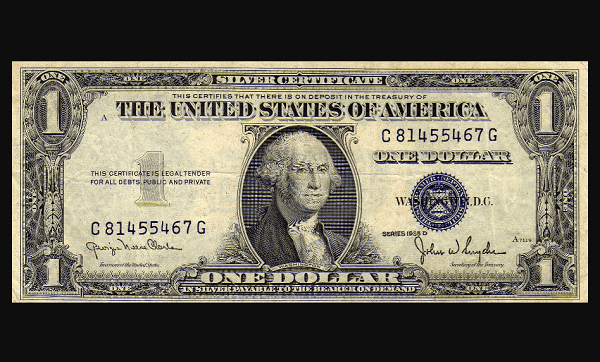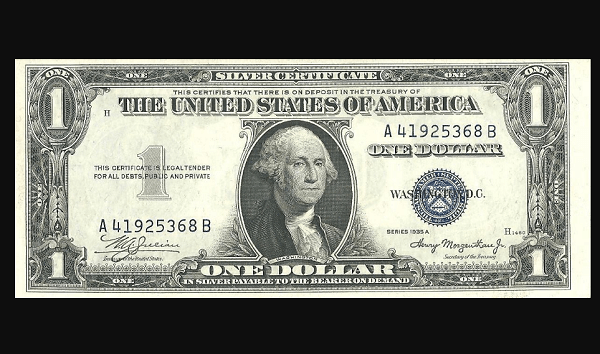1935 1 Dollar Bill Value – Have you ever stumbled upon an old stash of dollar bills, only to find a series of intricate designs and mysterious variations that leave you wondering about their true worth? Among the myriad of U.S. dollar bills, the 1935 one dollar bill stands out as a captivating piece of history, harboring secrets and nuances that define its value in the realm of currency collecting.
The 1935 $1 silver certificate was a significant departure from its predecessors, introducing a fresh design while retaining George Washington’s portrait.
This new rendition showcased the “All Seeing Eye” atop a pyramid on the left and the Great Seal on the right, distinguishing it from the previous versions. These bills emerged during the heart of the Great Depression, seeing extensive circulation and practical use.

Notably, the 1935 series underwent a subtle alteration that stirred a wave of curiosity among currency enthusiasts.
The shift from ½ millimeter to a full 1 millimeter in the size of Face and Backplate numerals between the 1935 and 1935A issues might seem insignificant.
However, this slight modification led to unforeseen consequences, giving rise to what collectors refer to as “MULES” – notes with different-sized plate numbers on the Face and Back.
During a transitional phase, some 1935 notes were printed using the larger Backplate numerals of the 1935A series, creating peculiar hybrids.
Conversely, as the 1935A series gained momentum, some notes bore the smaller Backplate numerals of the 1935 plates. These MULES became prized possessions for collectors due to their rarity and distinctive characteristics.
The allure of these variations extends beyond the standard 1935 series.
Notes from the 1935A $1 Hawaiian and North Africa issues, as well as the R and S Experimental notes, lack Mule varieties, adding layers of intrigue to the collecting world.
For avid collectors, the discovery of MULES amidst stacks of well-circulated 1935 and 1935A $1 silver certificates can prove rewarding. Scarcer blocks can command values of up to $500 in Gem Uncirculated condition, with rare variants like the DB block valued at $1,000.
Star notes fetch even higher prices, with some reaching astonishing values like the 1935 Mule star valued at $9,000 in Gem condition.
Beyond the 1935 series, similar phenomena of MULES exist in various denominations and series like the $2 and $5 Legal Tender notes and certain Federal Reserve notes, enriching the hunt for these elusive collectibles.
The value of a 1935 dollar bill fluctuates widely, with average conditions pegged at $1, while rare finds can soar to an impressive $16,000. Varieties in seal types – blue, brown, and yellow – further contribute to their diversity and worth.
Distinguishing between different series – 1935, 1935A, 1935B, and beyond – and exploring unique varieties like the experimental notes and region-specific seals unveils a rich tapestry of collectible currency ripe for exploration.
Armed with knowledge and curiosity, embrace the thrill of cherry-picking these historical artifacts and uncovering their hidden values.
1935 One Dollar Bill: The Iconic Design
Issued as a refreshing departure from its predecessor, the 1935 $1 silver certificate replaced the 1934 version, introducing a novel design that showcased notable alterations.
This rendition adorned George Washington’s portrait with an added large blue numeral one to the left, featuring an “All Seeing Eye” atop a pyramid on the left and the Great Seal on the right.
Amidst the Great Depression’s hardships, these bills bore witness to the everyday transactions of the time and reflect the country’s economic resilience.
Evolution into 1935A Series and Unique Variations
The transition to the 1935A series, distinguished by a minute yet impactful change in Face and Backplate numerals’ size, sparked unforeseen developments for currency collectors.
The slight adjustment from ½ to a full 1 millimeter in height led to the creation of unique hybrids known as “MULES.”
These notes, born from a convergence of printing plates during transitional phases, represent intriguing variations sought after by collectors for their scarcity and distinctive characteristics.
The 1935 series saw its plates interchanged during the 1935A production, resulting in MULES bearing different-sized plate numbers on the Face and Back.
The 1935B notes emerged later, the absence of MULES in subsequent series adds to the allure of these early variations.
1935 1 Dollar Bill Value and Collectibility
For collectors, the allure of these 1935 MULES lies in their scarcity and distinctiveness.
Scarcer blocks of these notes, especially those in Gem Uncirculated condition, can command significant values, with some reaching up to $500.

The rarity factor amplifies with Star notes, where specific variations like the 1935 Mule star can fetch astonishing values, reaching up to $9,000 in Gem condition.
Unique Varieties and Their Worth
Beyond the standard 1935 series, rare varieties such as the 1935A Experimental R and S Notes present captivating opportunities.
These experimental notes, denoted by red R or S markings, hold considerable value in the collector’s market.
The 1935A Hawaii and North Africa notes, marked by distinct seal colors and historic significance tied to wartime responses, are sought-after variations in the realm of currency collecting, often valued at $65 to $400, depending on their condition.
Grading, Rarity, and Error Considerations
Understanding the grading system, from notes in Very Fine condition to those graded MS 63 choice uncirculated, aids collectors in assessing their collection’s value.
Identifying errors, such as the absence of the ‘In God We Trust’ motto, which appeared only in later series, and the occasional misplacement of signatures, adds layers of intrigue for discerning collectors.
Evaluating Worth and Noteworthy Varieties
Assessing the worth of a 1935 one dollar bill involves recognizing unique serial numbers, seal types, and the series they belong to.
Specific varieties, like those with star notes or distinctive serial numbers, command higher values, with rare specimens selling for thousands of dollars in uncirculated condition.
The 1935 one dollar bill transcends its monetary value, serving as a tangible piece of history that encapsulates America’s economic journey.
How much is a 1935 $1 worth?
A 1935 $1 silver certificate bill, commonly found in circulation, typically holds a face value of $1. However, in pristine, uncirculated conditions, these bills can be valued significantly higher, reaching up to $18,000 in the open market based on their condition and rarity.
How much is a 1935 dollar bill without God we trust?
The Series 1935G dollar bills, despite lacking the motto “In God We Trust,” do not command a premium over their face value of $1. Collectors generally don’t assign extra value to these bills due to the absence of the motto.
Where is In God We Trust on a 1935 silver certificate?
The Series of 1935 $1 Silver Certificates notably did not feature the motto “In God We Trust.” This motto was introduced in later series, particularly with the Series of 1957, marking the inclusion of the motto on the back of the bill. It’s important to note that a limited number of Series of 1935 notes were produced in 1961 featuring the motto, albeit in small quantities.
Conclusion
The 1935 one dollar bill encapsulates a captivating narrative of historical evolution and collectible intrigue. Iconic design shifts to the intricacies of value assessment, rare variations, and unique features, these silver certificates offer a multifaceted landscape for both collectors and enthusiasts.
Understanding the nuances of different series, variations, and distinct characteristics provides a deeper appreciation for these tangible artifacts of American history.
Exploring the 1935 one dollar bill realm unravels a tale woven with historical significance, valuation diversity, and the allure of collectibility, making it a compelling pursuit for those fascinated by numismatics and the rich heritage of currency.